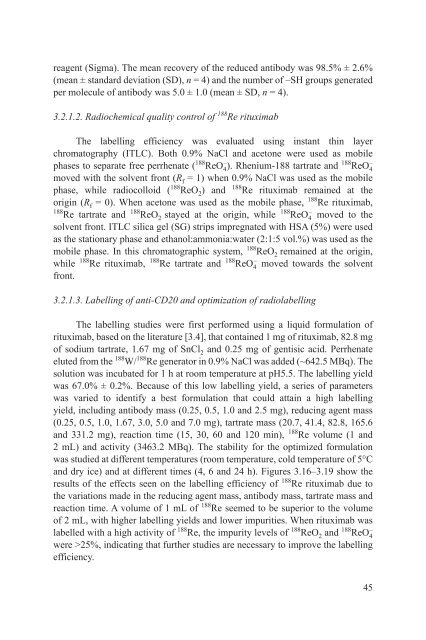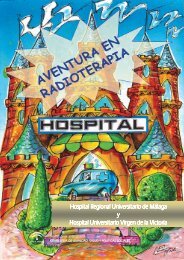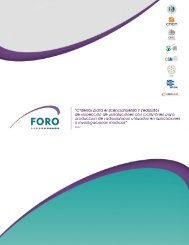Yttrium-90 and Rhenium-188 Radiopharmaceuticals for Radionuclide Therapy
Pub1662web-89688003
Pub1662web-89688003
Create successful ePaper yourself
Turn your PDF publications into a flip-book with our unique Google optimized e-Paper software.
eagent (Sigma). The mean recovery of the reduced antibody was 98.5% ± 2.6%<br />
(mean ± st<strong>and</strong>ard deviation (SD), n = 4) <strong>and</strong> the number of –SH groups generated<br />
per molecule of antibody was 5.0 ± 1.0 (mean ± SD, n = 4).<br />
3.2.1.2. Radiochemical quality control of <strong>188</strong> Re rituximab<br />
The labelling efficiency was evaluated using instant thin layer<br />
chromatography (ITLC). Both 0.9% NaCl <strong>and</strong> acetone were used as mobile<br />
phases to separate free perrhenate ( <strong>188</strong> ReO 4 – ). <strong>Rhenium</strong>-<strong>188</strong> tartrate <strong>and</strong> <strong>188</strong> ReO 4<br />
–<br />
moved with the solvent front (R f = 1) when 0.9% NaCl was used as the mobile<br />
phase, while radiocolloid ( <strong>188</strong> ReO 2 ) <strong>and</strong> <strong>188</strong> Re rituximab remained at the<br />
origin (R f = 0). When acetone was used as the mobile phase, <strong>188</strong> Re rituximab,<br />
<strong>188</strong> Re tartrate <strong>and</strong> <strong>188</strong> ReO 2 stayed at the origin, while <strong>188</strong> ReO 4 – moved to the<br />
solvent front. ITLC silica gel (SG) strips impregnated with HSA (5%) were used<br />
as the stationary phase <strong>and</strong> ethanol:ammonia:water (2:1:5 vol.%) was used as the<br />
mobile phase. In this chromatographic system, <strong>188</strong> ReO 2 remained at the origin,<br />
while <strong>188</strong> Re rituximab, <strong>188</strong> Re tartrate <strong>and</strong> <strong>188</strong> ReO 4 – moved towards the solvent<br />
front.<br />
3.2.1.3. Labelling of anti-CD20 <strong>and</strong> optimization of radiolabelling<br />
The labelling studies were first per<strong>for</strong>med using a liquid <strong>for</strong>mulation of<br />
rituximab, based on the literature [3.4], that contained 1 mg of rituximab, 82.8 mg<br />
of sodium tartrate, 1.67 mg of SnCl 2 <strong>and</strong> 0.25 mg of gentisic acid. Perrhenate<br />
eluted from the <strong>188</strong> W/ <strong>188</strong> Re generator in 0.9% NaCl was added (~642.5 MBq). The<br />
solution was incubated <strong>for</strong> 1 h at room temperature at pH5.5. The labelling yield<br />
was 67.0% ± 0.2%. Because of this low labelling yield, a series of parameters<br />
was varied to identify a best <strong>for</strong>mulation that could attain a high labelling<br />
yield, including antibody mass (0.25, 0.5, 1.0 <strong>and</strong> 2.5 mg), reducing agent mass<br />
(0.25, 0.5, 1.0, 1.67, 3.0, 5.0 <strong>and</strong> 7.0 mg), tartrate mass (20.7, 41.4, 82.8, 165.6<br />
<strong>and</strong> 331.2 mg), reaction time (15, 30, 60 <strong>and</strong> 120 min), <strong>188</strong> Re volume (1 <strong>and</strong><br />
2 mL) <strong>and</strong> activity (3463.2 MBq). The stability <strong>for</strong> the optimized <strong>for</strong>mulation<br />
was studied at different temperatures (room temperature, cold temperature of 5°C<br />
<strong>and</strong> dry ice) <strong>and</strong> at different times (4, 6 <strong>and</strong> 24 h). Figures 3.16–3.19 show the<br />
results of the effects seen on the labelling efficiency of <strong>188</strong> Re rituximab due to<br />
the variations made in the reducing agent mass, antibody mass, tartrate mass <strong>and</strong><br />
reaction time. A volume of 1 mL of <strong>188</strong> Re seemed to be superior to the volume<br />
of 2 mL, with higher labelling yields <strong>and</strong> lower impurities. When rituximab was<br />
labelled with a high activity of <strong>188</strong> Re, the impurity levels of <strong>188</strong> ReO 2 <strong>and</strong> <strong>188</strong> ReO 4<br />
–<br />
were >25%, indicating that further studies are necessary to improve the labelling<br />
efficiency.<br />
45




